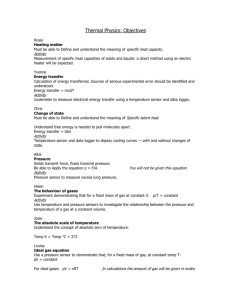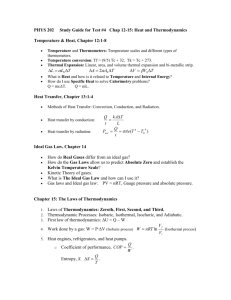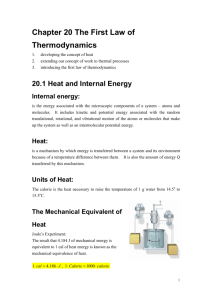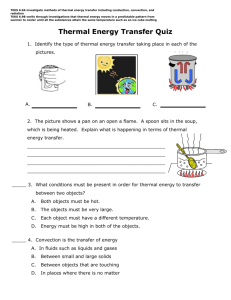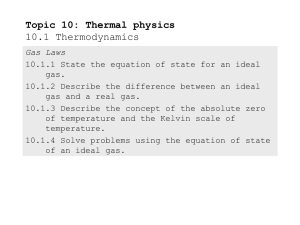sy24_nov24_f10
advertisement
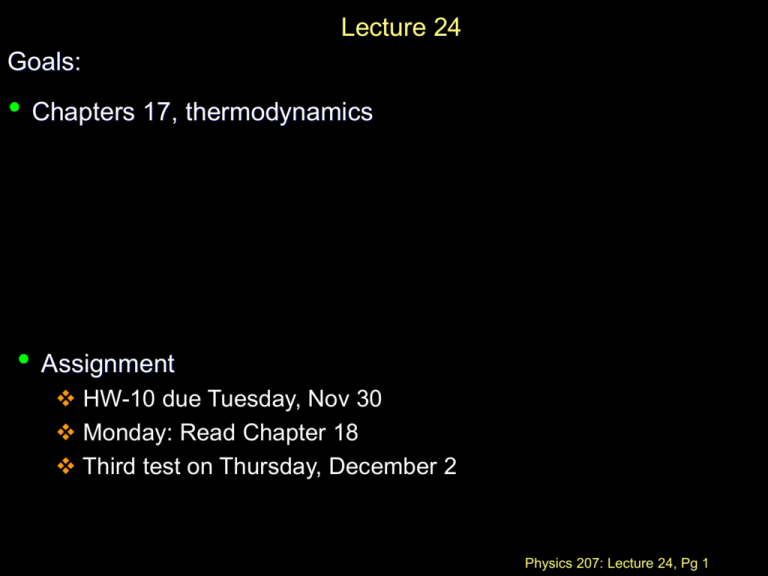
Lecture 24 Goals: • Chapters 17, thermodynamics • Assignment HW-10 due Tuesday, Nov 30 Monday: Read Chapter 18 Third test on Thursday, December 2 Physics 207: Lecture 24, Pg 1 First Law of Thermodynamics ΔU+ΔK+ΔEthermal=ΔEsystem=Wexternal+Q For systems where there is no change in mechanical energy: ΔEthermal =Wexternal+Q 1 calorie=4.186 Joules 1 food calorie=1000 calories Physics 207: Lecture 24, Pg 2 Pressure Isochoric process (const V) • Work is: -(the area under the curve) Pi W=0 • Using ideal gas law: Pf Volume PV=nRT Tf < Ti • From first law of thermodynamics we conclude: ΔEthermal =W+Q<0 Q<0 Physics 207: Lecture 24, Pg 3 Pressure Isothermal expansion (const T) • Temperature does not change Pi ΔEthermal=0 • Work done on the gas is: Pf Vi Vf W<0 Volume • From first law of thermodynamics we conclude: ΔEthermal =W+Q=0 Q=-W Physics 207: Lecture 24, Pg 4 Pressure Work in a isothermal process final Pi W PdV initial Vf nRT W Pf Vi Vi Vf Volume V dV Vf 1 W nRT dV Vi V Vf W nRT ln Vi Physics 207: Lecture 24, Pg 5 Pressure Isothermal compression • What is the change in thermal Pf energy? A) ΔEthermal=0 B) ΔEthermal <0 C) ΔEthermal >0 Pi Vf Vi Volume • What is the work done on the gas? A) W=0 B) W<0 B) W>0 • What direction is the thermal energy flow? A) Q=0 B) Q<0 B) Q>0 Physics 207: Lecture 24, Pg 6 Adiabatic processes Processes where there is no thermal energy transfer to or from the system: Q=0 This does not mean that there is no change in temperature. For adiabatic processes: PV constant Physics 207: Lecture 24, Pg 7 Thermal Properties of Matter Physics 207: Lecture 24, Pg 8 Heat of Transformation Latent heat of transformation L is the energy required for 1 kg of substance to undergo a phase change. (J / kg) Q = ±ML Heat of vaporization for water is L=2.3x106 J/kg. Q = +2.3x106 J 1 kg Q = -2.3x106 J Physics 207: Lecture 24, Pg 9 Temperature change and specific heat Specific heat c of a substance is the energy required to raise the temperature of 1 kg by 1 K. (Units: J / K kg ) Q = M c ΔT Specific heat for water is c=4190 J/ K kg. Q = +4190 J 1 kg T+1 K 1 kg TK Q = -4190 J Physics 207: Lecture 24, Pg 10 Exercise The specific heat (Q = M c ΔT) of aluminum is about twice that of iron. Consider two blocks of equal mass, one made of aluminum and the other one made of iron, initially in thermal equilibrium. Heat is added to each block at the same constant rate until it reaches a temperature of 500 K. Which of the following statements is true? (a) The iron takes less time than the aluminum to reach 500 K (b) The aluminum takes less time than the iron to reach 500 K (c) The two blocks take the same amount of time to reach 500 K Physics 207: Lecture 24, Pg 11 Specific heat for gases For gases we typically use molar specific heat (Units: J / K mol ) Q = n C ΔT For gases there is an additional complication. Since we can also change the temperature by doing work, the specific heat depends on the path. Q = n CV ΔT (temperature change at constant V) Q = n CP ΔT (temperature change at constant P) Physics 207: Lecture 24, Pg 12 Pressure Relationship between CP and CV P For path 1 ΔEthermal =W+Q=nCVΔT 2 1 Ti Tf ΔV Volume For path 2 ΔEthermal =W+Q =-PΔV+nCPΔT =-nRΔT+nCPΔT Equating both paths we get CP=CV+R Physics 207: Lecture 24, Pg 13 Monoatomic vs diatomic gases Molar specific heats of all monatomic gases are around CV≈12.5 J/K mol Molar specific heats of all diatomic gases are around CV≈20.8 J/K mol Physics 207: Lecture 24, Pg 14 Energy transfer mechanisms Thermal conduction (or conduction) Convection Thermal Radiation Physics 207: Lecture 24, Pg 15 Thermal conduction Energy transferred by direct contact. Rate of energy transfer ( J / s or W ) Through a slab of area A and thickness Dx, with opposite faces at different temperatures, Tc and Th Q / Dt = k A (Th - Tc ) / Dx k :Thermal conductivity (J / s m °C) Physics 207: Lecture 24, Pg 16 Energy transfer mechanisms Convection: Energy is transferred by flow of substance Natural convection: from differences in density Forced convection: from pump of fan Radiation: Energy is transferred by photons e.g.: infrared lamps Stefan’s Law P = s A e T4 (power radiated) s= 5.710-8 W/m2 K4 , T is in Kelvin, and A is the surface area e is a constant called the emissivity Physics 207: Lecture 24, Pg 17




